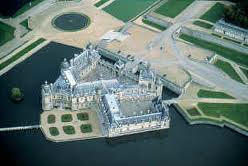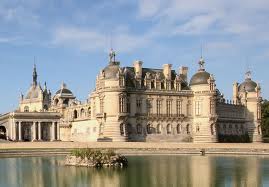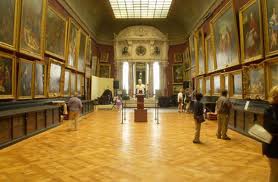The French region of Île-de-France is famous for its magnificent châteaux. Some of them are enormous, particularly Versailles, others may not be so imposing in size yet they give the visitor a deep historic feeling as well as insights of the France of days long gone, Château de Fontainebleau. However it's a shame to miss the breathtaking and dream like Château de Chantilly.

But Chantilly has more beautiful attractions to show as well as the château.
Take a walk in fairy tail gardens, enchanted forest and visit one of the world's most sumptuous stables (it actually looks like a palace). One of France's best art museums is in Chantilly. However, this town is famous for the delicate black lace that its made here and delicious (if a little caloric) whipped cream.
The whole package makes for a delightful foray into the French countryside, at comfortable 30 minutes from Paris.
Cantilius, originally from Rome build a villa in the location. After that one medieval Lord after the other built in intricate and complex fortresses and palaces. In the 17th century, Louis, Grand Condé (and Louis XIV’s cousin), had the château built and the king's gardener André Le Nôtre designed and created the beautiful gardens.
It was in the château's grounds that the world famous crème chantilly was invented.

Though Château de Chantilly was very badly damaged during the Revolution, King Louis-Philippe’s fifth son had it rebuilt in the 1870's. He also added many changes, among them its current facade, marble statues copied of Michelangelo, luscious gardens and the magnificent entrance hall.
Several interesting and odd historical facts are associated with Château de Chantilly that occurred in the 17th century.
From Madame de Sévigné's memoirs we know that when King Louis visited the castle in 1671, the Grand Condé's maître d'hôtel, a man named François Vatel killed himself at the prospect of the fish being served late. Luckily, the exacting standards of Louis XIV do not apply to your average tourist.
Château de Chantilly's gardens are very extensive and although there is a suggested walking tour, a relaxed wander works just as well.
Highlights include the idyllic play-village hameau (hamlet), the inspiration for Marie Antoinette’s hamlet at Versailles and the recently added kangaroo enclosure (the 15 or so wallabies gathered in the far right corner of the formal gardens) which is a fitting monument to the former royal flare.
Another great attraction of the château is the Grandes Écuries (stables). It has huge marble corridors, beautiful courtyards and much more to see. It was Louis-Henri Bourbon who commissioned it for a very strange reason: he was hoping to live in the Grandes Écuries once he died and reincarnated in a horse. Crazy? Perhaps so, but it's worth a visit and seeing its impressive architecture anyway.
From the beginning of the 18th century to the Revolution, the Grandes Écuries lodged some 240 horses and hundreds of hunting dogs. Today it is Musée Vivant du Cheval, its impressive and extensive collection is dedicated to horse and anything related them. It is said to be the largest of its kind in the world.

The town's biggest attraction can be found within Château de Chantilly: the amazing Musée Condé lodges the Duc d’Aumale’s private collection of pre-modern paintings. It is one of the two museums in entire France that has three Raphael paintings. The other may be found in the Louvre.
In the museums galleries we can find some 8000 paintings, many by famous artists such as Titian, Corot, Botticelli, Delacroix, Reynolds, Watteau, and Ingres. There are also a few thousands drawings, a number of other art objects such as engravings, sculptures, and tapestries.
The most famous room, the Santuario (sanctuary), contains what the Duke himself considered the finest works in his collection.
This hidden gallery contains two celebrated works by Italian painter Raphael — the Three Graces and the Orleans Virgin — plus an miniature assemblage by the notorious French painter, Jean Fouquet.
Trains leave from the Gare du Nord in Paris almost hourly for the 30-minute ride to Chantilly-Gouvieux. Return service operates until early evening. There are also RER commuter service trains, which are a little slower. Château de Chanitlly is a scenic 25 minute walk from the train station which is well sign-posted.
The castle is open everyday except Tuesday from April to November, 10am to 6pm. The gardens close at 8pm. From November to March the château is closed on Tuesdays but opens Monday and Wednesday to Friday from 10:30am to 12:45pm and 2pm to 5pm. On weekends and holidays it is open 10:30am to 5pm and the gardens close at 6pm.